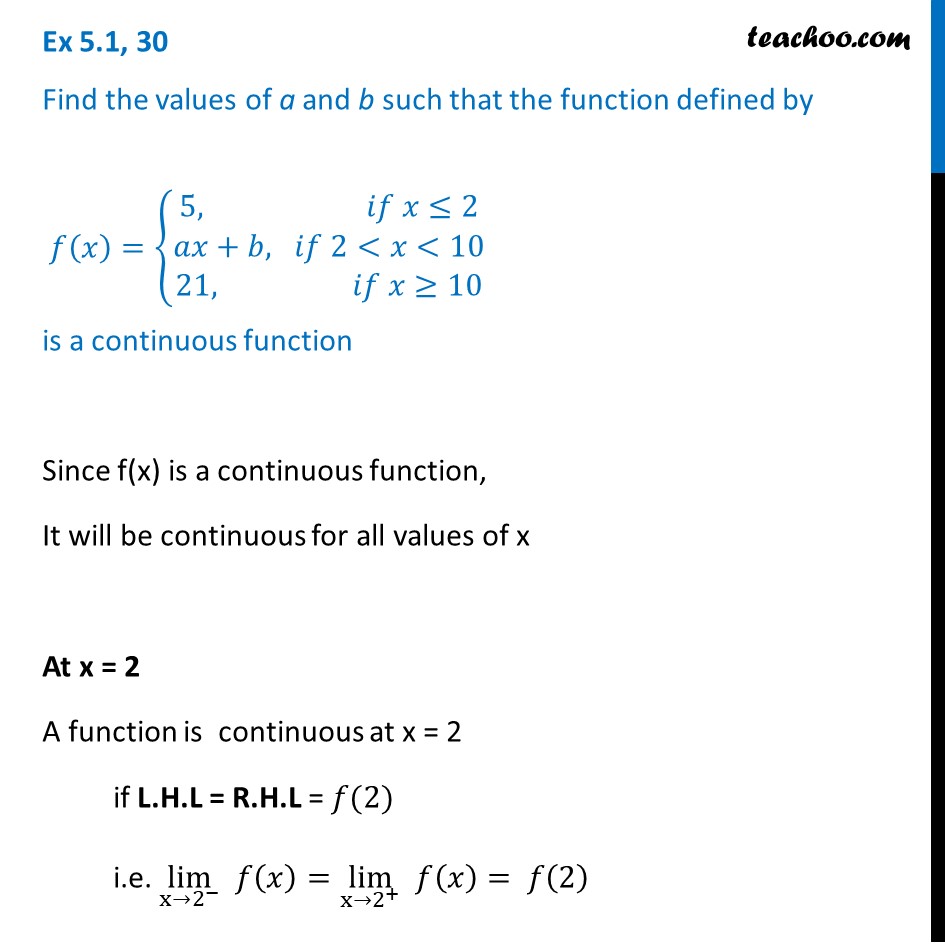




Ex 5.1
Ex 5.1 ,2
Ex 5.1, 3 (a)
Ex 5.1, 3 (b)
Ex 5.1, 3 (c) Important
Ex 5.1, 3 (d) Important
Ex 5.1 ,4
Ex 5.1 ,5 Important
Ex 5.1 ,6
Ex 5.1 ,7 Important
Ex 5.1 ,8
Ex 5.1, 9 Important
Ex 5.1, 10
Ex 5.1, 11
Ex 5.1, 12 Important
Ex 5.1, 13
Ex 5.1, 14
Ex 5.1, 15 Important
Ex 5.1, 16
Ex 5.1, 17 Important
Ex 5.1, 18 Important
Ex 5.1, 19 Important
Ex 5.1, 20
Ex 5.1, 21
Ex 5.1, 22 (i) Important
Ex 5.1, 22 (ii)
Ex 5.1, 22 (iii)
Ex 5.1, 22 (iv) Important
Ex 5.1, 23
Ex 5.1, 24 Important
Ex 5.1, 25
Ex 5.1, 26 Important
Ex 5.1, 27
Ex 5.1, 28 Important
Ex 5.1, 29
Ex 5.1, 30 Important You are here
Ex 5.1, 31
Ex 5.1, 32
Ex 5.1, 33
Ex 5.1, 34 Important
Last updated at April 16, 2024 by Teachoo





Ex 5.1, 30 Find the values of a and b such that the function defined by 𝑓(𝑥)={█(5, 𝑖𝑓 𝑥≤2@𝑎𝑥+𝑏, 𝑖𝑓 2<𝑥<10@21, 𝑖𝑓 𝑥≥10)┤ is a continuous function Since f(x) is a continuous function, It will be continuous for all values of x At x = 2 A function is continuous at x = 2 if L.H.L = R.H.L = 𝑓(2) i.e. lim┬(x→2^− ) 𝑓(𝑥)=lim┬(x→2^+ ) " " 𝑓(𝑥)= 𝑓(2) LHL at x → 2 (𝑙𝑖𝑚)┬(𝑥→2^− ) f(x) = (𝑙𝑖𝑚)┬(ℎ→0) f(2 − h) = lim┬(h→0) 5 = 5 RHL at x → 2 (𝑙𝑖𝑚)┬(𝑥→2^+ ) f(x) = (𝑙𝑖𝑚)┬(ℎ→0) f(2 + h) = lim┬(h→0) a(2 + h) + b = a(2 + 0) + b = 2a + b Since, LHL = RHL 2a + b = 5 At x = 10 𝑓 is continuous at x = 10 if L.H.L = R.H.L = 𝑓(10) i.e. lim┬(x→10^− ) 𝑓(𝑥)=lim┬(x→10^+ ) " " 𝑓(𝑥)= 𝑓(10) LHL at x → 10 (𝑙𝑖𝑚)┬(𝑥→10^− ) f(x) = (𝑙𝑖𝑚)┬(ℎ→0) f(10 − h) = lim┬(h→0) a(10 − h) + b = a(10 − 0) + b = 10a + b RHL at x → 10 (𝑙𝑖𝑚)┬(𝑥→10^+ ) f(x) = (𝑙𝑖𝑚)┬(ℎ→0) f(10 + h) = lim┬(h→0) 21 = 21 Since, L.H.L = R.H.L 10a + b = 21 Now, our equations are 2a + b = 5 …(1) 10a + b = 21 …(2) From (1) 2a + b = 5 b = 5 − 2a Putting value of b in (2) 10𝑎+(5−2𝑎) = 21 10𝑎+5−2𝑎 = 21 8𝑎 = 21−5 8𝑎 = 16 𝑎 = 16/8 𝒂 = 𝟐 Putting value of a in (1) 2𝑎+𝑏=5 2(2)+𝑏=5 4+𝑏=5 𝑏=5−4 𝒃=𝟏 Hence, a = 2 & b = 1